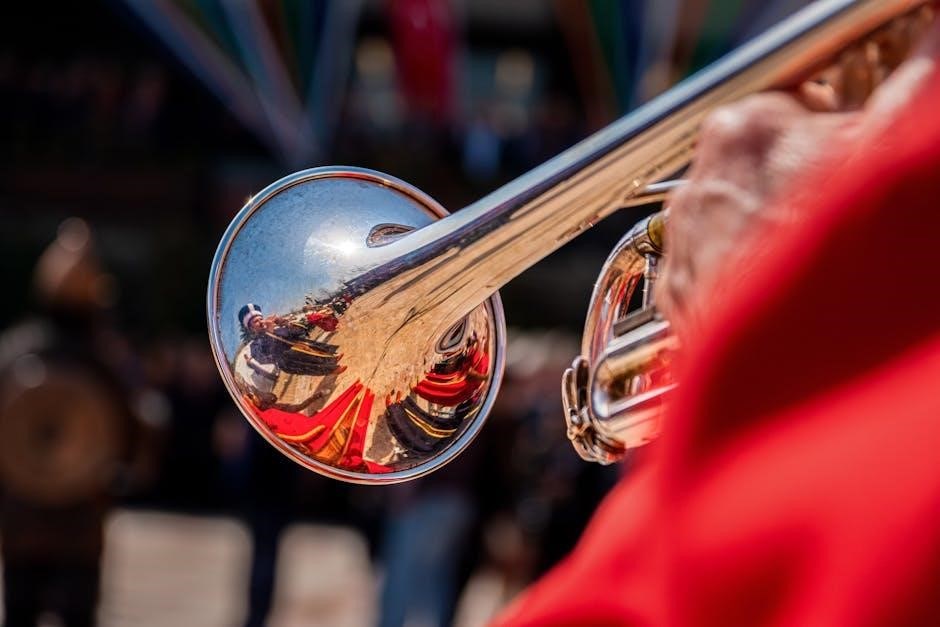Petite Piece Concertante by Guillaume Balay is a lyrical and technically demanding composition for trumpet and piano, showcasing the instrument’s expressive capabilities․ Its sheet music is widely available in PDF format, making it a popular choice for trumpet enthusiasts and educators․
1․1 Overview of the Composition
Petite Piece Concertante is a captivating composition by Guillaume Balay, specifically written for trumpet and piano․ This piece is known for its lyrical melodies and technical demands, making it a popular choice for trumpet players․ The composition is relatively short, with a playing time of approximately 3 minutes and 20 seconds, allowing for a concise yet impactful performance․ It is structured to highlight the trumpet’s expressive qualities, with the piano providing a supportive and harmonically rich accompaniment․ The piece is often praised for its balance between musicality and technical challenge, making it a favorite among both students and professional musicians․ Its availability in PDF format has further enhanced its accessibility, ensuring it remains a staple in trumpet repertoire․
1․2 Historical Background
Petite Piece Concertante was composed by Guillaume Balay, a prominent figure in the development of trumpet repertoire․ The piece reflects Balay’s dedication to creating works that highlight the trumpet’s lyrical and technical capabilities․ Written in the mid-20th century, it became a cornerstone of modern trumpet literature, blending classical traditions with contemporary expressiveness․ The composition gained popularity for its accessibility and artistic depth, making it a favorite among educators and performers alike․ Its historical significance lies in its role as a bridge between traditional concertante forms and modern trumpet techniques․ Over time, the piece has been widely performed and admired, solidifying its place in the trumpet repertoire․ The availability of its sheet music in PDF format has further cemented its enduring popularity among musicians worldwide․
Composer Background
Guillaume Balay is a prominent composer known for his contributions to trumpet repertoire, blending lyrical and technical elements in his works, influencing modern trumpet music significantly with accessible yet artistically deep compositions․
2․1 Biography of Guillaume Balay
Guillaume Balay was a French composer and arranger, primarily active in the early 20th century․ Known for his contributions to wind instrument repertoire, Balay’s works often featured lyrical melodies and technical challenges․ His compositions, such as Petite Piece Concertante, were designed to showcase the trumpet’s expressive capabilities, blending elegance with virtuosity․ Balay’s music remains popular in trumpet education and performance, offering a balance of artistic depth and technical demands․ His legacy is marked by a dedication to creating accessible yet sophisticated music for solo and chamber settings, making him a respected figure in trumpet literature․

2․2 Balay’s Contributions to Trumpet Music
Guillaume Balay significantly enriched the trumpet repertoire through his compositions, particularly with works like Petite Piece Concertante․ His music often combined lyrical phrasing with technical demands, providing both a showcase for virtuosity and a platform for expressive interpretation․ Balay’s compositions were tailored to highlight the trumpet’s tonal versatility, making them essential pieces in trumpet education and performance․ His contributions have left a lasting impact on the development of trumpet literature, offering a blend of accessibility and sophistication that continues to inspire musicians․ Balay’s work remains a cornerstone in the study and appreciation of trumpet music, ensuring his legacy endures in the world of classical instrumentation․
Structure and Form
Petite Piece Concertante is a concise, single-movement work with a clear beginning, development, and conclusion․ Its structure features lyrical themes, technical passages, and dynamic contrasts, lasting approximately 3:20 minutes․

3․1 Musical Structure of the Piece
Petite Piece Concertante is a single-movement work for trumpet and piano, lasting approximately 3 minutes and 20 seconds․ The piece begins with a lyrical theme introduced by the trumpet, accompanied by a simple yet effective piano accompaniment․ As the piece progresses, it develops into a technically demanding section with rapid arpeggios and dynamic contrasts, showcasing the trumpet’s agility․ The structure includes a crescendo leading to a climactic moment, followed by a ritardando that brings the piece to a serene conclusion․ The interplay between the trumpet and piano is balanced, with both instruments sharing melodic and harmonic responsibilities․ This concise yet expressive form makes it a popular choice for trumpet players seeking to demonstrate both technical proficiency and musicality․
3․2 Analysis of the Composition’s Form
Petite Piece Concertante is structured as a single-movement work, lasting approximately 3 minutes and 20 seconds․ The composition follows a clear tempo and dynamic progression, with distinct sections that highlight both lyrical and technical playing․ The piece begins with a melodic introduction by the trumpet, supported by a harmonic piano accompaniment․ It then transitions into a more virtuosic section, featuring rapid arpeggios and dynamic contrasts, showcasing the trumpet’s technical capabilities․ The form includes a crescendo leading to a climactic moment, followed by a ritardando that resolves the piece․ The balance between the trumpet and piano creates a cohesive dialogue, with each instrument sharing melodic and harmonic responsibilities․ This concise yet expressive structure makes it an ideal piece for educational purposes, emphasizing both technical precision and musical expression․

Instrumentation
Petite Piece Concertante is scored for trumpet and piano, with the trumpet often played in Bb․ It can also be performed on a cornet, showcasing versatility in instrumentation․
4․1 The Role of the Trumpet
The trumpet is the solo instrument in Petite Piece Concertante, showcasing its lyrical and technical capabilities․ It is typically performed on a Bb trumpet, which provides a bright and clear tone․ The piece demands a strong, expressive sound, with intricate passages that highlight the player’s agility and control․ The trumpet’s role is central, often carrying the melodic line while interacting with the piano accompaniment․ The composition is well-suited for intermediate to advanced players, offering a balance of musicality and technical challenge․ The availability of the sheet music in PDF format has made it accessible for trumpet enthusiasts to practice and perform this beloved piece․
4․2 The Role of the Piano
The piano plays a crucial role in Petite Piece Concertante, serving as both an accompaniment and a harmonic foundation․ It provides a rich, dynamic backdrop that complements the trumpet’s melodic lines․ The piano’s part is intricate, requiring a high level of technical skill and musical sensitivity․ It often alternates between rhythmic support and expressive counterpoint, creating a balanced dialogue with the trumpet․ The interplay between the two instruments is essential, with the piano enhancing the emotional depth of the piece․ The sheet music, available in PDF format, ensures that pianists can accurately interpret the nuances of the composition, making it a valuable resource for collaborative performance․

Performance Considerations
Petite Piece Concertante demands precise attention to tempo, dynamics, and phrasing․ The trumpet and piano must balance expressively, with careful articulation and tonal control to achieve a polished performance․
5․1 Tempo and Dynamics
The tempo of Petite Piece Concertante is marked at a moderate pace, typically around 120 beats per minute, allowing for both lyrical expression and technical precision․ Dynamics play a crucial role, ranging from delicate pianissimo passages to powerful fortissimo climaxes․ The trumpet and piano must carefully balance their volumes to maintain musical dialogue․ Phrasing and articulation are equally important, with legato sections requiring smooth transitions and staccato passages demanding crisp clarity․ Proper breath control and finger dexterity are essential for executing dynamic contrasts and maintaining a consistent tone․ The interplay between tempo and dynamics creates a vibrant, engaging performance that highlights the piece’s emotional depth and technical demands․
5․2 Technical Challenges for Trumpet Players
Petite Piece Concertante presents several technical challenges for trumpet players, including complex phrasing, rapid passages, and dynamic shifts․ The piece requires precise articulation, particularly in staccato sections, and strong breath control for sustained notes․ Trumpet players must master finger dexterity to navigate intricate melodic lines and chromatic passages․ Additionally, the piece demands accurate intonation, especially in the upper register, where pitch accuracy is critical․ Proper embouchure strength and flexibility are essential to maintain a consistent tone across the instrument’s range․ Players should also focus on phrasing and musicality to convey the piece’s lyrical and expressive qualities․ Regular practice, including slow tempos and recording sessions, can help refine technique and ensure a polished performance․
Sheet Music and PDF Availability
Petite Piece Concertante sheet music is readily available in PDF format for trumpet and piano․ It can be downloaded from various online platforms, ensuring easy access for performers․

6․1 Sources for Downloading the PDF
The sheet music for Petite Piece Concertante is available in PDF format from various online platforms․ Websites like Musicnotes, SheetMusicPlus, and IMSLP offer high-quality downloads․ These platforms provide easy access to the score, ensuring musicians can obtain the piece legally and efficiently․ Additionally, some music libraries and educational institutions may offer free or discounted access to the PDF․ It’s important to verify the authenticity and completeness of the sheet music before downloading․ Many sites also include previews, allowing users to review the content․ This widespread availability makes Petite Piece Concertante accessible to trumpet players and pianists worldwide, facilitating both performance and educational use․
6․2 Features of the Sheet Music
The sheet music for Petite Piece Concertante is meticulously arranged for trumpet and piano, ensuring clarity and precision․ The PDF format provides crisp notation, making it easy for musicians to interpret the composition․ It includes detailed dynamics, articulations, and phrasing marks, essential for an authentic performance․ The score is typically 72 pages long, with key sections highlighted for practice and rehearsal․ Tempo markings and rhythmical nuances are clearly indicated, guiding performers through the piece’s lyrical and technical passages․ Additional features may include performance notes and historical context, enhancing the musician’s understanding․ The sheet music is suitable for both advanced students and professionals, offering a balanced mix of challenge and musicality․ Its clean layout and professional presentation make it a valuable resource for trumpet enthusiasts․

Practice and Rehearsal Tips

Start with slower tempos to master technical passages․ Use a metronome for precise rhythm․ Focus on challenging sections individually․ Practice with a pianist for balanced dynamics and phrasing․
7․1 Effective Practice Techniques
Effective practice for Petite Piece Concertante involves breaking the piece into manageable sections․ Start by practicing at slower tempos to ensure technical accuracy and musicality․ Use a metronome to maintain precise rhythm and gradually increase speed as confidence grows․ Focus on challenging passages, such as fast runs or high notes, and isolate them for targeted practice․ Pay attention to dynamics and phrasing, as these elements are crucial for expressing the piece’s lyrical nature․ Incorporate long tones and lip slurs to improve tone quality and endurance․ Additionally, practice with a pianist to develop ensemble balance and timing․ Record sessions to identify areas for improvement and maintain a practice log to track progress․ Consistency and patience are key to mastering this demanding yet rewarding composition․
7․2 Rehearsal Strategies for Optimal Performance
Rehearsing Petite Piece Concertante effectively requires a structured approach․ Begin by rehearsing with a pianist to establish ensemble cohesion and balance․ Use a metronome to refine timing and ensure synchronization between trumpet and piano․ Focus on dynamics and phrasing, as these are critical for conveying the piece’s emotional depth․ Practice challenging sections at slower tempos and gradually increase speed․ Communicate with your accompanist to align interpretations and nuances․ Record rehearsals to identify and address intonation, articulation, and rhythmic accuracy․ Incorporate breath control exercises to maintain stamina during demanding passages․ Schedule regular rehearsals to build consistency and confidence․ Finally, perform the piece for others to simulate concert conditions and refine stage presence․ These strategies will help achieve a polished and engaging performance of Petite Piece Concertante․
Notable Performances and Recordings
Petite Piece Concertante has been performed by renowned trumpet players and orchestras worldwide․ Its lyrical beauty and technical demands make it a favorite at competitions and recitals․ Maurice André’s recording is particularly celebrated for its precision and artistry, setting a benchmark for interpretations․ The piece is frequently featured in classical music festivals, showcasing its enduring appeal․ Many professional and amateur musicians have shared their performances online, further popularizing the work․ These recordings and performances highlight the composition’s significance in trumpet repertoire and its ability to connect with diverse audiences․
8․1 Famous Performances of the Piece
Petite Piece Concertante has been performed by numerous renowned trumpet virtuosos, with Maurice André’s rendition being particularly iconic․ His interpretation is celebrated for its technical brilliance and emotional depth, setting a high standard for the piece․ Other notable performances include those by trumpeters like Wynton Marsalis and Alison Balsom, who have showcased the work’s lyrical and virtuosic qualities․ The piece has also been featured in international competitions, such as the Maurice André International Trumpet Competition, further cementing its reputation․ Many modern artists have recorded it, sharing their unique interpretations online․ These performances highlight the composition’s enduring appeal and its ability to inspire both classical music enthusiasts and aspiring trumpet players worldwide․
8․2 Recommended Recordings
For a deeper appreciation of Petite Piece Concertante, several recordings stand out as exceptional interpretations․ Maurice André’s rendition is often regarded as the gold standard, offering a masterclass in phrasing and technical precision․ Wynton Marsalis’s recording is another highlight, blending lyrical elegance with virtuosic flair․ Alison Balsom’s interpretation is also noteworthy, delivering a refined and expressive performance․ These recordings are widely available on platforms like Spotify, YouTube, and Apple Music, making them accessible to listeners worldwide․ Additionally, modern artists such as Tine Thing Helseth and Omar Tomasoni have released compelling versions, showcasing the piece’s versatility․ These recordings not only provide inspiration but also serve as valuable references for trumpet students and enthusiasts seeking to explore the composition’s nuances․

Educational Value
Petite Piece Concertante is a valuable educational resource for trumpet students, enhancing technical and musical skills through its accessible PDF sheet music and structured composition, ideal for developing phrasing and lyrical expression․
9․1 Use in Trumpet Education
Petite Piece Concertante is widely regarded as an essential piece in trumpet education, offering a balanced blend of technical and lyrical challenges․ Its accessible PDF sheet music makes it a popular choice for students and educators alike․ The composition’s structured format allows for focused practice on phrasing, dynamics, and articulation, making it ideal for developing intermediate to advanced trumpet players․ Educators often incorporate this piece into lesson plans to enhance students’ ability to interpret musical nuances and refine their tone production․ Additionally, its concise length ensures that students can master the piece within a reasonable timeframe, providing a sense of accomplishment and boosting confidence․ As a result, Petite Piece Concertante remains a cornerstone of trumpet pedagogy, fostering both technical proficiency and artistic expression․
9․2 Pedagogical Benefits
The Petite Piece Concertante offers significant pedagogical benefits, particularly in developing trumpet players’ technical and musical skills․ Its structured composition provides clear challenges, such as intricate phrasing and dynamic contrasts, which help students refine their control and expression․ The piece’s moderate difficulty level makes it accessible to intermediate learners while still offering advanced players opportunities to polish their technique․ Additionally, the availability of PDF sheet music ensures easy access for educators and students, facilitating its integration into lesson plans․ The composition’s focus on lyrical playing and precise articulation helps students develop a well-rounded approach to trumpet performance․ These elements make Petite Piece Concertante a valuable tool for fostering musical growth and technical mastery in educational settings․
Cultural Impact
Petite Piece Concertante has enriched the trumpet repertoire, offering a beloved piece that bridges technicality and artistry, widely embraced by musicians and audiences, enhancing its cultural significance․
10․1 Influence on Trumpet Repertoire
Petite Piece Concertante by Guillaume Balay has significantly influenced the trumpet repertoire, offering a lyrical and technically demanding piece that highlights the instrument’s expressive range․ Its availability in PDF format has made it accessible to musicians worldwide, fostering its popularity in both educational and performance settings․ The composition’s balance of melody and technical challenges has made it a staple in trumpet education, inspiring countless players to master its nuances․ Additionally, its concise structure and emotional depth have solidified its place as a beloved concert piece, contributing to the evolution of trumpet music․ This work continues to be celebrated for its ability to showcase both the artistic and technical capabilities of the trumpet, leaving a lasting impact on the repertoire․

10․2 Reception in Musical Circles
Petite Piece Concertante has been warmly received in musical circles, praised for its lyrical beauty and technical demands․ Trumpet players and educators often highlight its emotional depth and accessibility, making it a favorite in both educational and professional settings․ The piece’s availability in PDF format has further enhanced its popularity, allowing widespread access for study and performance․ Audiences appreciate its concise yet expressive structure, which showcases the trumpet’s capabilities․ Its reception has been particularly positive among trumpet enthusiasts, who value its balance of melody and technical challenges․ This piece continues to be celebrated as a timeless addition to the trumpet repertoire, resonating with both students and seasoned musicians alike․ Its enduring appeal underscores its significance in modern trumpet music․
Comparison with Other Works
Petite Piece Concertante stands out among similar trumpet concertantes for its unique blend of lyricism and technicality, offering a fresh perspective while maintaining classical traditions․ Its concise structure and emotional depth set it apart, making it a distinctive yet complementary piece within the trumpet repertoire․ The availability of its sheet music in PDF format has also contributed to its popularity compared to other works, ensuring its accessibility for both performance and study․ This piece is often praised for its ability to connect with audiences on an emotional level, a quality that distinguishes it from other concertantes․ Its balance of complexity and approachability makes it a favorite among both students and professionals, solidifying its place in the trumpet music landscape․
11․1 Similar Pieces by Balay
Guillaume Balay’s compositions often reflect a blend of lyricism and technical brilliance, as seen in Petite Piece Concertante․ Other notable works by Balay, such as Prélude et Ballade and Intrada, share similar characteristics, featuring intricate trumpet parts and harmonic richness․ These pieces, like Petite Piece Concertante, are designed to showcase the trumpet’s expressive capabilities, blending melodic elegance with virtuosic demands․ Balay’s style consistently emphasizes emotional depth and structural clarity, making his works popular among trumpet players․ The availability of sheet music in PDF format for these pieces, including Petite Piece Concertante, has further enhanced their accessibility and appeal to musicians worldwide․ Balay’s contributions to trumpet repertoire remain significant, offering a diverse range of challenges and artistic expression for performers at various levels․ His music continues to be celebrated for its balance of technicality and musicality․
11․2 Comparison to Other Trumpet Concertantes
Petite Piece Concertante stands alongside other notable trumpet concertantes, such as works by Honegger and Bohme, in its technical and expressive demands․ While Honegger’s Intrada is known for its dramatic intensity, Balay’s piece offers a more lyrical and nuanced approach․ Similarly, Bohme’s concertantes often feature virtuosic flourishes, whereas Balay’s work emphasizes melodic elegance․ The availability of Petite Piece Concertante in PDF format has made it accessible to a wide audience, much like other popular trumpet concertantes․ However, Balay’s unique blend of French lyrical style and technical brilliance sets his work apart․ This piece remains a staple in trumpet repertoire, providing a rewarding challenge for performers while maintaining artistic depth․ Its concise structure and expressive qualities make it a favorite among both students and professionals․
Petite Piece Concertante remains a timeless gem in trumpet repertoire, offering a blend of lyrical elegance and technical brilliance․ Its availability in PDF ensures accessibility for performers, solidifying its place as a cherished piece for both students and professionals․
12․1 Significance of Petite Piece Concertante
Petite Piece Concertante holds a special place in trumpet literature, celebrated for its lyrical beauty and technical demands․ Composed by Guillaume Balay, it is a cornerstone of trumpet education, offering students a piece that bridges artistic expression and technical mastery․ Its availability in PDF format has made it accessible to musicians worldwide, ensuring its enduring popularity․ The work is often featured in recitals and competitions, showcasing its relevance in modern trumpet repertoire․ Balay’s composition not only highlights the trumpet’s expressive qualities but also underscores the importance of collaboration between trumpet and piano․ As a result, Petite Piece Concertante remains a cherished and influential piece, fostering growth for aspiring trumpet players while delighting audiences with its elegant charm․
12․2 Final Thoughts on the Composition
Petite Piece Concertante by Guillaume Balay is a timeless composition that continues to captivate trumpet enthusiasts and educators․ Its elegant blend of lyricism and technical brilliance makes it a cornerstone of trumpet repertoire․ The piece’s availability in PDF format has democratized access, allowing musicians worldwide to engage with it․ As a staple in recitals and competitions, it remains a benchmark for artistic and technical excellence․ Balay’s work not only highlights the trumpet’s expressive potential but also fosters a deep connection between performer and audience․ Its enduring popularity underscores its significance in trumpet education and performance, ensuring its legacy as a cherished piece in classical music․ For both learners and seasoned musicians, Petite Piece Concertante offers a rewarding and inspiring experience․